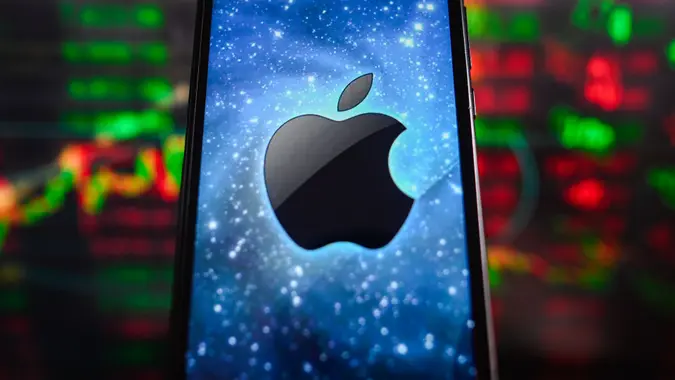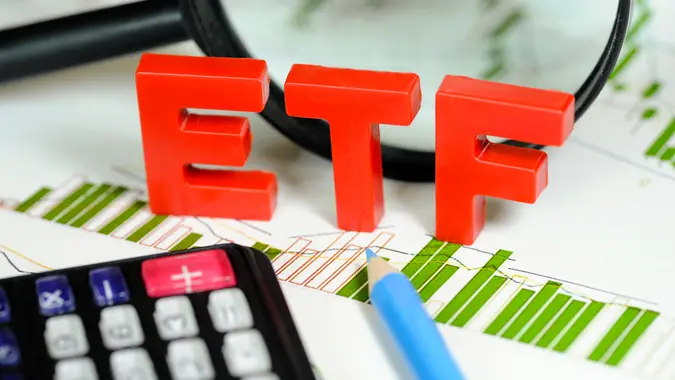How To Buy Cryptocurrency: Simple Guide To Get Started

Commitment to Our Readers
GOBankingRates' editorial team is committed to bringing you unbiased reviews and information. We use data-driven methodologies to evaluate financial products and services - our reviews and ratings are not influenced by advertisers. You can read more about our editorial guidelines and our products and services review methodology.

20 Years
Helping You Live Richer

Reviewed
by Experts

Trusted by
Millions of Readers
Cryptocurrency, also called crypto, is a digital or virtual currency that isn’t backed by a central government or bank. Since crypto doesn’t require an intermediary, exchanges can happen between one individual to another. Although cryptocurrency is a fairly new investment, it is a way to diversify your existing portfolio. There is some risk involved, but the returns may cement your financial success.
The future of finance seems to be moving in the direction of crypto. As of January 2025, according to Statista, there are over 10,500 different cryptocurrencies. Here’s a guide on how to buy crypto.
Steps To Buy Cryptocurrency
To the uninitiated, cryptocurrency can be unfamiliar and intimidating. But buying it is a fairly straightforward process that you can do in just five steps.
Step 1: Decide Which Cryptocurrency To Purchase
The first step is to settle on which cryptocurrencies to buy. This comes first because different exchanges support different coins. You don’t want to register an account with an exchange only to learn that it doesn’t list the coins you want to own.
All the top exchanges list the brand-name heavyweights, like Bitcoin, Ethereum, Tether and BNB. But there are thousands of cryptocurrencies in the world, and most exchanges support just a few dozen or a few hundred.
Do your research carefully and select coins based on your goals for your portfolio.
Step 2: Set Up a Crypto Wallet
Setting up your digital wallet is an important part of the process when buying cryptocurrency. A digital wallet is a secure place that is used to send, receive and store your cryptocurrency. It is best to set up your crypto wallet prior to making your purchase of the currency.
Here is a list of crypto wallets that you should consider:
- Hot wallets. These are applications or programs set up on your computer or phone. Although they are user friendly, they can be vulnerable to security risks because they are connected to the internet.
- Cold wallets. If you want to store significant amounts of cryptocurrency long-term, consider a cold wallet. Cold wallets are physical devices that store your private keys offline. Since these wallets aren’t connected to the internet, they are considered more secure.
- Exchange wallets. These wallets are maintained by an exchange. The exchange holds and manages your private keys on your behalf. Security is maintained by the exchange which could leave you vulnerable to risk.
Step 3: Choose a Cryptocurrency Exchange
When you settle on the coins you want to buy, find an exchange that supports those tokens — but don’t base your decision solely on that. The most critical factors are security, safety, reputation, support for fiat currencies, liquidity, fees and transaction speed.
Here are some common centralized exchanges:
- Coinbase: This exchange is best for beginners who have strong security measures. Coinbase has fewer crypto options compared to competitors and has high fees.
- Binance: Binance has low trading fees and altcoin availability. Binance has advanced trading features, but it is not as regulated, and customer service isn’t ideal.
- Kraken: Kraken has strong security measures and is regulated giving users peace of mind that their transactions will be safe. This exchange has low fees, allows trades on margin and offers futures. One drawback is that this exchange may be too complex for beginners.
- Gemini: Ideal for beginners and with good security features, Gemini is a good exchange for customers in the U.S. The fees are high for small exchanges, and there is limited availability of altcoins.
Step 4: Deposit Funds into Your Account
To set up an account, link a payment method or deposit fiat currency. Some of the top exchanges allow you to purchase crypto with debit and credit cards, but others do not. Because of fees, it’s often cheapest to deposit cash through an ACH transfer and buy your coins with old-fashioned money even if your exchange does accept plastic.
Either way, setting up an account and linking a payment method is not unlike signing up for PayPal, Venmo or any other platform that facilitates financial transactions.
Step 5: Make Your First Purchase
Navigate to the trading section of the site, pick the crypto you wish to purchase and the amount, and submit your order.
Different Ways To Buy Cryptocurrency
There’s not just one way to buy crypto. Here’s a look at three different ways you can build your cryptocurrency portfolio.
Buying Through an Exchange
The most popular way to buy cryptocurrency is through a centralized exchange. These platforms are usually user friendly, and you can use bank transfers, credit and debit cards, or PayPal to make your purchase.
Some common centralized exchanges are Binance, Coinbase, Kraken and Gemini.
Peer-to-Peer Transactions
You can buy crypto directly from others using a variety of payment methods like cash, bank transfers and gift cards. Common P2P platforms are platforms are Paxful and LocalBitcoins.
Bitcoin ATMs
You can purchase Bitcoin through a kiosk. You can use cash or a card to purchase Bitcoin. However, there are high fees associated with a Bitcoin ATM.
Where To Buy Cryptocurrency
You may be ready to buy crypto but unfamiliar where to make your purchase. Here are three options available to make your cryptocurrency purchase.
Top Crypto Exchanges
If you’re familiar with crypto, you may have heard of centralized exchanges. Those exchanges are places like Coinbase, Binance, Kraken and Gemini. These exchanges generally have user-friendly platforms and security features.
Decentralized Exchanges
Unlike centralized exchanges, decentralized exchanges do not have a middleman responsible for the purchase. Users control their funds, and there is wider access to tokens.
DEX is more secure since there is no central point of failure. Some popular DEX examples are Uniswap, PancakeSwap and SushiSwap.
Wallet Providers and Apps
If you want to buy cryptocurrency directly, you can use apps like Trust Wallet and MetaMask.
- Trust Wallet is available only on your phone and supports multiple blockchains. You can earn rewards and swap tokens.
- Unlike Trust Wallet, MetaMask is available on your phone and computer. MetaMask generally supports ethereum, but allows for custom additions.
How Much Does It Cost To Buy Crypto?
Buying crypto comes with several associated costs. Many of the fees are dependent on the exchange, payment method and the blockchain network. Here is a brief overview of the fees and hidden costs associated with buying crypto.
Fees Associated With Buying Crypto
- Trading fees: If you buy or sell crypto, you will pay a trading fee. Typically the fee is 0.1% to 0.5% per transaction. If you trade in high volume, the trading fee could be reduced.
- Withdrawal fee: If you transfer your crypto to an external wallet, you will likely be charged a network fee. Network fees vary by blockchain.
- Transaction costs: Paying with credit or debit cards usually has a higher fee, while bank transfer or ACH transfer has lower costs.
Hidden Costs To Watch For
It is especially important to understand the fine print when you purchase crypto. Beware of some of these hidden fees:
- Network fees: Some blockchains charge a network or gas fee when there is extra congestion.
- Platform fees: Some exchanges add an extra service fee when you buy crypto. This makes the purchase price higher than the market rate.
- Exchange rate spreads: Certain exchanges may not charge an upfront fee, but may offer a slightly worse exchange rate that will increase the overall cost.
Keeping Your Crypto Safe
Once you buy some crypto, it’s important to keep it safe. The next step is protecting it from hackers, scams, and accidental loss. Unfortunately, crypto theft is real, and once your coins are gone, there’s no “reset password” button to get them back.
One of the best ways to secure your assets is by using a hardware wallet–a physical device that stores your crypto offline, away from internet threats. For everyday use, you might also have a hot wallet (connected to the internet), but it’s smart to only keep a small amount there, kind of like how you wouldn’t carry all your cash around in your wallet.
No matter what kind of wallet you use, enable two-factor authentication (2FA) wherever you can, and don’t share your private keys or seed phrase. Think of those like the keys to your digital safe. If someone else gets them, they have full control over your funds.
Keeping your crypto secure doesn’t have to be complicated–but a few extra precautions can go a long way toward giving you peace of mind.
Should You Invest in Crypto?
Whether you decide to invest in crypto means you need to figure out if the risks are worth the reward of the investment. Here is a brief overview of the risks and rewards:
Risks of Crypto Investment
- Navigating Volatility. The prices of crypto can fluctuate and change rapidly. For instance, in May 2022, Bitcoin plunged 30% in one day. This kind of drop can make any investor nervous. Having a long-term outlook on how crypto fits into your overall financial strategy can help navigate drops in the currency.
- Uncertainty of Regulation. Regulation of crypto is treated differently from state to state and from one federal agency to another. Since crypto isn’t tied to a physical asset and its price is driven by what people are willing to pay for it, regulations become hard to draft and enforce. Crypto markets are evolving, and individuals will have to wait and see how various laws and policies may impact crypto they are purchasing now or in the future.
- Concerns About Security. In 2023, approximately $1.7 billion of cryptocurrency was stolen. The number of hacking incidents grew from 219 in 2022 to 231 in 2023. Although cryptocurrency exchanges have cold storage and multi-factor authentication in place, there are still security risks.
Potential Rewards
- Possibility of High Returns. Bitcoin, for example, has a return rate of 230% — that’s 10 times higher than the returns of a traditional investment like the NASDAQ. If you’re willing to flow with crypto’s risk and potential volatility, chances are the payoff will be huge.
- Allows Diversification of Your Portfolio. Your portfolio may have traditional assets such as stocks, retirement accounts, mutual funds and retirement accounts like an IRA or 401(k). Having cryptocurrency allows you to add another dimension to your financial strategy.
- More Control Since Crypto Is Decentralized. No central bank or government backs cryptocurrency. Since cryptocurrency is decentralized, it operates on a peer-to-peer network using blockchain technology. This ensures transparency, security and resistance to censorship.
FAQ
Here are the answers to some of the most frequently asked questions about buying crypto.- Can I buy cryptocurrency with a credit card?
- Yes, you can buy cryptocurrency with a credit card, but it depends on the exchange and your card issuer. Some banks do not allow crypto purchases, while others treat them as cash advances, which can result in higher fees and interest rates.
- What is the minimum amount of crypto I can buy?
- The minimum amount varies based on the exchange and type of crypto you want to purchase.
- Platforms like Binance, Coinbase and Kraken allow purchases as low as $1 to $10. Bitcoin allows individuals to buy a fraction of a coin.
- How long does it take for crypto to appear in my wallet?
- How quickly crypto appears in your wallet depends on the blockchain network, exchange processing times and transaction fees.
- Bitcoin (BTC) takes 10 to 60 minutes to appear in your wallet.
- Ethereum (ETH) takes a few minutes to 30 minutes to appear in your wallet.
- Solana (SOL) appears instantly or in a few seconds.
- How quickly crypto appears in your wallet depends on the blockchain network, exchange processing times and transaction fees.
- Is buying cryptocurrency with PayPal safe?
- Yes, buying cryptocurrency is generally safe on PayPal. The PayPal platform has built-in security and fraud protection.
- How do I know if an exchange is trustworthy?
- Check if the exchange is registered with financial authorities and offers security features like cold storage and multi-factor authentication. Read customer reviews and feedback to determine what users say about the exchange.
- A trustworthy exchange allows for easy deposits and withdrawals. Fees and company info should also be transparent.
Andrew Lisa contributed to the reporting for this article.
Our in-house research team and on-site financial experts work together to create content that’s accurate, impartial, and up to date. We fact-check every single statistic, quote and fact using trusted primary resources to make sure the information we provide is correct. You can learn more about GOBankingRates’ processes and standards in our editorial policy.
- CoinMarketCap. "CoinMarketCap."
- Forbes Advisor. 2022. "Different Types of Cryptocurrencies."
- Coinbase. "Create a Coinbase account."
- Time NextAdvisor. 2022. "You Can Buy Crypto With a Credit Card — But You Shouldn’t. Here’s Why."
- Blockchain Council. 2022. "Types Of Crypto Wallets Explained."
- Coinbase. "Understanding the order types."
- CoinGecko. "Top Decentralized Exchanges Ranked by 24H Trading Volume."
- SoFi Learn. 2022. "What Is a Decentralized Exchange (DEX)?"
- Forbes Advisor. 2022. "How To Buy Cryptocurrency."
- Statista. 2025. "Number of cryptocurrencies worldwide from 2013 to January 2025."
- CNBC. 2021. "Bitcoin plunges 30% to $30,000 at one point in wild session, recovers somewhat to $38,000."
- Chainalysis. 2024. "Funds Stolen from Crypto Platforms Fall More Than 50% in 2023, but Hacking Remains a Significant Threat as Number of Incidents Rises."
 Written by
Written by  Edited by
Edited by 
























